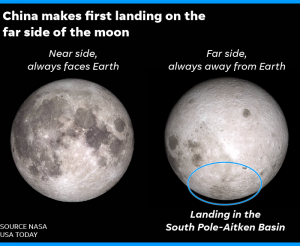
Multiple spacecrafts have touched down on the near side of the moon, which faces Earth, but this is the first-ever landing on the dark side. USA TODAY
It’s sometimes referred to as the “dark side of the moon.” Sorry, Pink Floyd fans, but there is plenty of light on what is typically known as the moon’s far side.
On Thursday, China’s growing space program said it landed a spacecraft on the far side of the moon for the first time ever.
“This is a first for humanity and an impressive accomplishment,” wrote NASA administrator Jim Bridenstine on Twitter.
A photo taken by the spacecraft shows a small crater and barren surface, and there’s a lot more researchers hope to learn about this elusive spot on the moon. Here’s what we know about the moon’s so-called dark side:
Why do we have a far side of the moon?
According to astronomers at Cornell University, the moon is tidally locked to earth, which means it exerts tidal forces strong enough to cause the moon to only show one side as it orbits. Also, there is no such thing as a dark side of the moon, says NASA. Both sides are alternately lit as it rotates.
How much do we know about the far side? Not a lot, which is why astronomers are so excited about China landing a spacecraft in the area. In 1959, the Soviet Luna 3 spacecraft shared the first images of the moon’s far side, said NASA. Since then, several NASA missions have captured additional images with more detail. In 2015, a camera aboard the Deep Space Climate Observatory (DSCOVR) satellite captured a view of the fully-illuminated far side.
What makes it different? The far side features far more craters, some of which are the size of small countries, reports Space.com. The side we see shows more basaltic plains called “mare,” said the report, which were created by volcanic activity billions of years ago.
Wait, we might grow potatoes on the moon?!?! The BBC reports the Chinese lander is carrying six live species from Earth: cotton, rapeseed, fruit fly, yeast, a flowering plant named arabidopsis and potatoes. The goal is to try to form a mini-biosphere.
Brett Molina, USA TODAY
